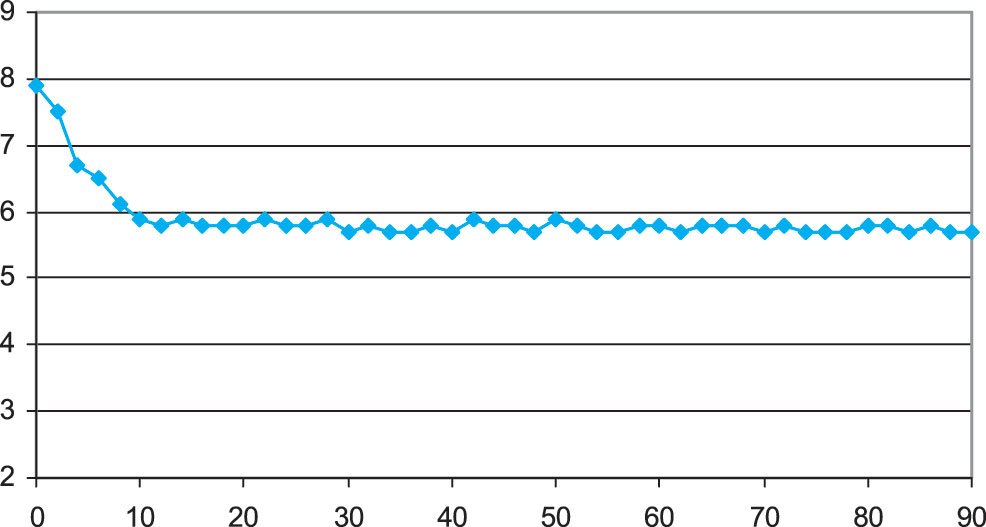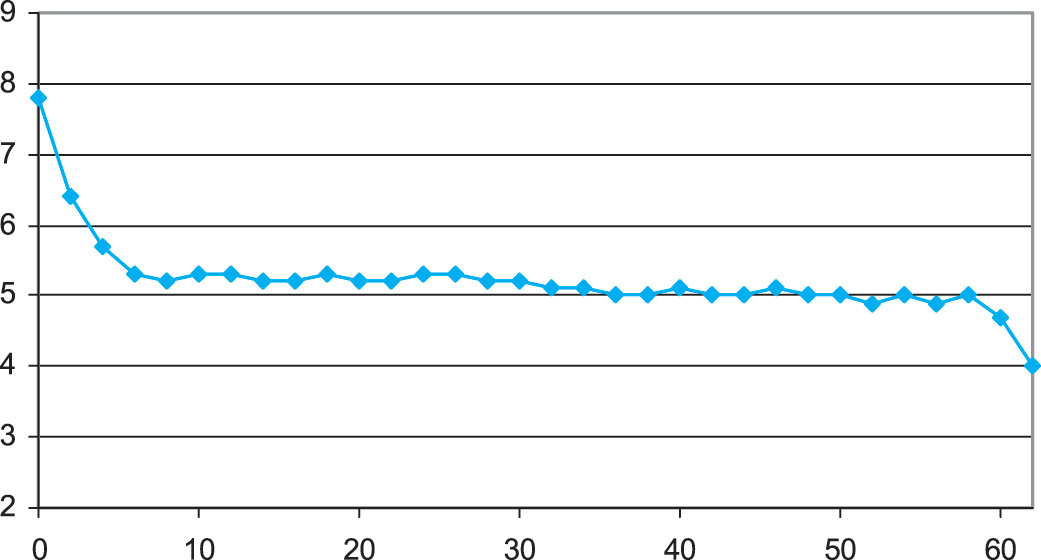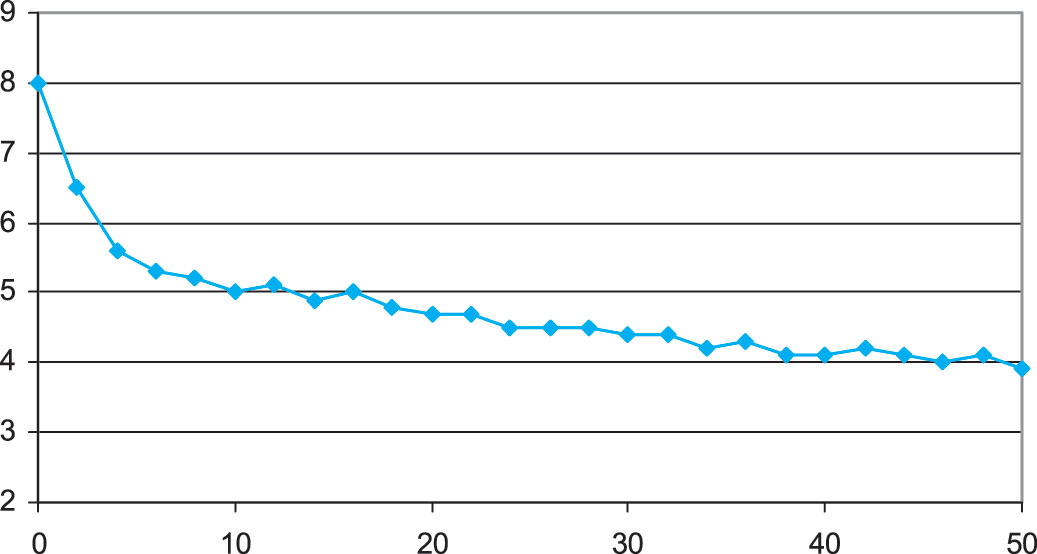Fatigue Assessment at Physical Education and Sports Classes
Фотографии:
ˑ:
M.M. Polevschikov, professor, Ph.D.
A.M. Shraga, associate professor, Ph.D.
V.E. Afon'shin, candidate
Mari State University, Yoshkar-Ola
V.V. Rozhentsov, professor, Dr.Tech.
Volga State University of Technology, Yoshkar-Ola
Key words: training, fatigue assessment, light pulse-pair technique.
Introduction. Fatigue is a major problem of physiology of physical education and sport and one of the most pressing issues of medicobiological evaluation of athletes' training and competitive activities. Knowing the mechanisms of fatigue and stages of its development one can properly assess athletes' functional status and physical working capacity. This information should be considered when developing measures of health protection and achievement of high results in sport.
It is not reasonable to train without fatigue, when the mechanisms of increase of efficiency and endurance development are not activated. In the process of doing physical exercises the arising fatigue increases gradually, so the moment of training termination should be determined individually in each particular case. For this it is necessary to fulfill two conditions that naturally contradict each other [8]:
– to provide a substantial amount of work done in the condition of progressing fatigue, as this is what ensures the training effect of classes;
– the duration of training in the state of fatigue should not be long enough for fatigue to turn into exhaustion.
As noted in the work [10], most authors claim the need for an integrated approach to the fatigue and overwork diagnostics, based on the methods of estimation of performance or the state of a number of physiological and psychological functions, which have been reviewed [11]. However, the main focus is on the search for informative techniques of fatigue diagnostics based on biochemical, physiological or psychophysiological indicators.
Psychophysiological state of the human body is the first and very sensitive indicator of changes occurring in the body [4]. The effect of physical load on the parameters of analyzer systems and a decrease in their functionalities and increase of the level of their thresholds were determined [5]. Previously, the authors have showed that fatigue can be assessed using the methods of critical frequency of light flashing and paired light pulses [9, 10].
The purpose of the study was to develop a method of individual assessment of fatigue during physical education and sports classes, which contributes to its more accurate diagnostics.
Materials and methods. The method is based on determining the time of excitation that characterizes the rate of excitatory processes in the central nervous system (CNS) [12]. The subject is subject to a test on a bicycle ergometer with a constant load of 75% of predicted maximal oxygen consumption, and a sequence of pairs of light pulses is presented to him; the pulses have the duration of 200 milliseconds, are separated by an initial inter-pulse interval (IPI) of 70 milliseconds and are repeated with a constant time interval of 1 second.
During testing the threshold IPI at which two pulses in a pair merge into one is defined every two minutes using the successive approximations method [9]. According to the obtained values of the threshold IPI, a graph of its dynamics is created in the “threshold IPI values - testing time” coordinates. The testing stops once the values of the threshold IPI decrease sharply or by decision of a doctor.
The retesting is made after two days of rest with the load increased according to the recommendations [3] by 50 W, as long as the threshold IPI dynamics graph has no downward trend.
The subject’s state of fatigue is determined by the previous threshold IPI graph that has a “plateau” by the time of a sharp decrease of its values [6].
Results and discussion. The study involved 10 trained athletes aged 20 to 22 years with normal vision, specializing in cyclic sports: long-distance runners and cross country skiers. Subjects’ qualifications included the 1st degree and Candidate Master of Sport.
The testing was performed in the morning, from 9 am to 12 pm, light pulses were presented binocularly. As an example we hereby present the test results of the subject T, aged 22, Candidate Master of Sport in cross-country skiing. The subject performed the test using the Kettler X1 ergometer exercise bike model № 7681-000 in the sitting position with the speed of pedaling of 60 rpm. The volume of the load of constant power is taken to be 195 W, corresponding to 75% of predicted maximal oxygen consumption determined by nomograms of B.P. Prevarsky. During the testing the doctor constantly monitored the state of the subject by his appearance, heart rate and blood pressure, and changes of these served for him as grounds for termination of the test. The threshold IPI dynamics graph during testing is presented in Figure 1.

Figure 1. Threshold IPI dynamics graph during testing with the load of 195 W.
Here and in Figures 2, 3: the horizontal axis - testing time, minutes; the vertical axis - threshold IPI value, milliseconds.
The analysis of the threshold IPI dynamics graph during testing shows no decrease of its values. This indicates that the state of the CNS during testing does not change, its fatigue does not occur during the test under the given load.
The subject T was retested after two days of rest with the load of 245 W corresponding to 94% of predicted maximal oxygen consumption (MOC) determined by the nomograms of B.P. Prevarsky, and then after two more days of rest with the load of 295 W corresponding to 114% of predicted maximal oxygen consumption determined by the nomograms of B.P. Prevarsky. The threshold IPI dynamics graph of the last test is presented in Figure 2.

Figure 2. Threshold IPI dynamics graph during testing with the load of 295 W.
Analysis of the threshold IPI dynamics graph during testing reveals the state of fatigue by the time period of a sharp decrease of the threshold IPI values that is 58 minutes. At this time one should finish testing, otherwise further load will lead to exhaustion.
The subject T was retested after two days of rest with the load of 345 W corresponding to 132% of predicted MOC determined by the nomograms of B.P. Prevarsky.
The testing was terminated at the request of the doctor. The threshold IPI dynamics graph of the test is presented in Figure 3.

Figure 3. Threshold IPI dynamics graph during testing with the load of 345 W.
The analysis of the threshold IPI dynamics graph during testing shows that the load of 345 W, corresponding to 132% of predicted MOC, is excessive for the T subject since the graph has a downward trend.
The fact that the threshold IPI dynamics graph reached the “plateau” during testing indicates that the CNS is in a quasi-stationary regime, i.e. the processes of regulation of vegetative functions in all the organs and body systems are completed and the entire body is indeed in a state of optimum performance. The variability of threshold IPI values is observed in the quasi-stationary regime, caused by the stochasticity of the CNS as a complex biological object.
Changes in the body due to the development of fatigue are in the incoordination of processes in the organs and systems of the body, increase of the physiological value of work [13]. The status of the CNS responsible for the regulation of processes occurring in the human body is changing. The CNS enters the state of tension as evidenced by a sharp decrease of the threshold IPI between two pulses in a pair.
The organization of the training process should be based on the study of the dynamics of functional abilities of athletes during different training periods. One of the ways to train qualified athletes is to introduce into the training process scientifically validated control methods based on the analysis of express information about physiological and biological parameters that enable an objective assessment of the functional status of the CNS [1].
The basic properties of nervous processes (strength, lability, mobility, dynamism, balance), level of their functional tension, the status of the psycho-emotional sphere of the body largely determine the overall adaptation strategy, its effectiveness and psychological readiness for training and competitive activities, determine peculiarities of individual behavior of an athlete in various sports situations. Thanks to determination of psychophysiological parameters of athletes the functional state of the CNS and the degree of fatigue at sports occupations can be evaluated and an individual amount of physical exercise and its intensity are set preventing the state of fatigue [14].
Thus, the total time of reaction to a signal was proved to depend on the functional status of a person including fatigue, the type of the higher nervous activity, the level of vigilance. The time of reaction to a signal reflects both sensory excitability (the receptor and central apparatus) and functional mobility [2]. According to V.M. Bashkin [1], this method is used to determine the most important indicator of the functional status of the CNS - the degree of fatigue - quickly and without the use of complex tests and clinical research, and based on the results of examination of athletes enables the trainer to adjust the training process in real time.
In cyclic sports, especially when running, the CNS provides control over movements made at a very high speed that require a high level of excitability and lability of nerve centers, mobility and balance of nervous processes, although the leading systems that ensure work in this sphere are oxygen transport systems. The following are used to estimate the parameters of the CNS functioning: critical flicker fusion frequency reflecting lability and mobility of nervous processes; methodology of determining the speed and sharpness of visual perception; tapping test to assess the type of nervous system; reaction to a moving object reflecting the balance of nervous processes; a simple visual-motor reaction characterizing functional mobility of nervous processes. Determination of neurophysiological features of track and field athletes contributes to quick assessment of the functional status of the CNS, the degree of fatigue at sports occupations, adjustment of individual volume and intensity of physical load avoiding the development of the fatigue phase [7].
However, as noted by V.M. Bashkin [1], the data of literature review and interviews with experts in physiology have shown that very few highly reliabile and informative methods can determine the functional status of the CNS of athletes in dynamics.
The proposed method of fatigue assessment using paired light pulses by means of analysis of the threshold IPI dynamics can be used directly at physical education and sports occupations and facilitates the improvement of the accuracy of its diagnostics.
Conclusion. The method of individual assessment of fatigue during physical education and sports classes by analyzing the dynamics of threshold pulse separation is presented in this paper. It characterizes the rate of excitatory processes in the CNS. Proceeding from the study, the proposed method can be used for fast determination of the functional status of the CNS, the degree of fatigue at sports occupations, for adjusting individual volume and intensity of physical load to prevent the development of fatigue.
References
- Bashkin, V.M. The study of changes in the functional status of the central nervous system of athletes during different training periods / V.M. Bashkin // Uchenye zapiski universiteta im. P.F. Lesgafta. – 2009. – № 9. – P. 8–11. (In Russian)
- Dumbay, V.N. Speed indicators of sensorimotor reactions and tapping test of primary schoolchildren in different years of school study / V.N. Dumbay // Valeologiya. – 2004. – № 3. – P. 42–50. (In Russian)
- Zaytseva, V.V. Estimation of information value of ergometric indicators of working capacity / V.V. Zaytseva, V.D. Son'kin, M.V. Burchik, I.A. Kornienko // Fiziologiya cheloveka. – 1997. – V. 23. – № 6. – P. 58–63. (In Russian)
- Il'in, E.P. Differential psychophysiology / E.P. Il'in. – St. Petersburg: Nauka, 2001. – 235 P. (In Russian)
- Krasnov, M.M. Ophthalmologic practice and overall health / M.M. Krasnov // Vestnik oftal'mologii. – 2003. - № 4. – P. 4–6. (In Russian)
- Patent 2491015 RF, MPC А63В 3/00. The method for determining human fatigue / Yu.A. Minakov, M.M. Polevschikov, V.V. Rozhentsov, V.E. Afon'shin; applicant and patentee Mari state university. - № 2012118871/14; decl. 05.05.2012; publ. 27.08.2013, Bul. №24. – 14 P. (In Russian)
- Petrova, T.G. Neurophysiological status and its relationship with athletes' morphotypes / T.G. Petrova, A.V. Shakhanova, N.N. Khasanova, G.M. Konovalova // Vestnik Adygeyskogo gosudarstvennogo universiteta. Series 4: Natural-mathematic and technical sciences. – 2012. – № 1. – P.116–122. (In Russian)
- Platonov, V.N. Training of elite swimmers / V.N. Platonov, S.M. Vaytsekhovsky. – Moscow: Fizkul'tura i sport, 1985. – 256 P. (In Russian)
- Polevschikov, M.M. Determination of the onset of fatigue in a man when performing physical load using psychophysiological methods / M.M. Polevschikov, V.V. Rozhentsov, Yu.S. Palagin, R.Yu. Matveev // Vestnik vosstanovitel'noy meditsiny. – 2010. – № 3. – P. 22–24. (In Russian)
- Rozhentsov. V.V. Individualization of fatigue control during physical education and sports classes / V.V. Rozhentsov // Teoriya i praktika fizicheskoy kultury. – 2004. – № 1. – P. 46–48. (In Russian)
- Rozhentsov. V.V. Fatigue during physical education and sport classes: problems, research methods: monograph / V.V. Rozhentsov, M.M. Polevschikov. – Moscow: Sovetsky sport, 2006. – 280 P. (In Russian)
- Rozhentsov. V.V. Estimate of the rate of excitation process of the athlete's nervous system / V.V. Rozhentsov, M.M. Polevschikov // Sportivny psikholog. – 2010. – № 2. – P. 74–77. (In Russian)
- Smirnov, K.M. Intensity of work / K.M. Smirnov // Uspekhi fiziologicheskikh nauk. – 1984. – V. 15. – № 1. – P. 76–99. (In Russian)
- Shakhanova, A.V. Psychophysiological profile and vegetative status in young football players and basketball players aged 10-15 years who train according to the schedule of the specialized children's sport school of Olympic reserve / A.V. Shakhanova, I.S. Belenko, A.A. Kuz'min // Vestnik Adygeyskogo gosudarstvennogo universiteta. Series 4: Natural-mathematic and technical sciences. – 2008. – № 9. – P. 78–90. (In Russian)
Corresponding author: mmpol@yandex.ru



